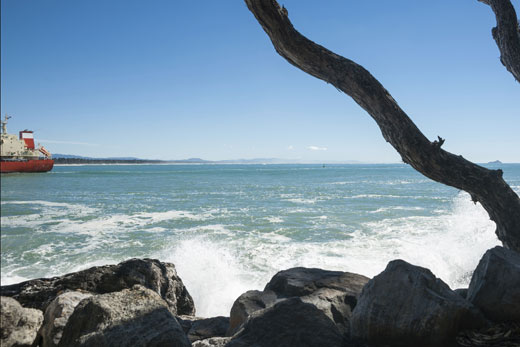The Astrolabe Reef will soon become only the second navigational hazard in the country to be marked by a virtual beacon, triggering proximity alarms on all ships carrying the Automatic Identification System.
The system is carried on all shipping over 300 tonnes, and was on board the containership Rena when it struck the unmarked reef early on October 5, 2011. Rena owners and insurers will be sponsoring the beacon.
Electronic markers are planned for the harbour to warn of hazardous reefs and shoals.
Regional harbourmaster Peter Buell says: 'This is modern equipment that is already installed on most big vessels that pass through our harbours, so it makes sense to have it, especially for such a busy port as the Port of Tauranga.
'The approach to the Port of Tauranga has a number of underwater hazards lying near the routes taken by ships.
'There will be seven markers, and we can install more if we need to.
'The markers are electronic, and appear only on ship navigational systems. A hazard – such as Astrolabe Reef (Otaiti) where the Rena grounded – appears as a digital information object on the ship's navigation system, electronic charts and radar.”
The approaches will have the electronic markers by early next year, alerting both ships and the regional council of vessels heading towards a charted danger or entering a no-go zone around each hazard.
The markers will be linked to Astrolabe reef, Brewis Shoal, Okaparu reef, Penguin shoal, Pudney Rock, Tūhua reef and Volkner rocks initially. The hardware part of the system will be on the Minden - the same place that the Port has equipment.
Peter says the Council had considered a physical beacon on Astrolabe Reef, but it would be impossible to maintain in the reef's challenging environment.
After receiving an offer to fund the implementation of additional navigational aids, the Council embarked upon a tendering process, with Vesper Marine winning the contract - the same company that provided Virtual Aids to Navigation in the Auckland area.
'We can expand the system as needed,” he adds.
'We're still working on the timings for the system to be operational but are targeting the first quarter of next year.
'This will be a substantial step forward in navigation safety in the Bay of Plenty. While not all vessels right now will see these aides, about 70 per cent will and that figure will climb in the future.”



2 comments
Overit
Posted on 23-12-2014 15:20 | By overit
Nothing like closing the stable door after the horse has bolted.
Oh yeah
Posted on 23-12-2014 17:34 | By YOGI BEAR
After the event, great news for the fish, sharks and wildlife then isn't it.
Leave a Comment
You must be logged in to make a comment.